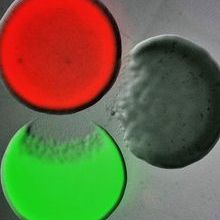Explore the Bacterial Competitive Mechanisms collection
22 August 2023

This month we are pleased to share the Microbiology Bacterial Competitive Mechanisms collection, guest edited by Professor Despoina A.I. Mavridou (The University of Texas at Austin, USA), Professor Tracy Palmer (Newcastle University, UK) and Dr Sabrina L. Slater (The University of Texas at Austin, USA).
Bacteria are found in every environment and live in complex communities, which are characterized by large densities and diverse compositions. In these microbiomes, bacteria constantly compete for resources, such as nutrients, space and oxygen. Bacteria use a vast arsenal to eliminate their competitors, from elaborate contact-dependent nano-harpoons to small diffusible toxic compounds. In addition to producing these, oftentimes, elaborate weapons, bacteria also employ a range of collective behaviours that, in turn, allow them to carefully regulate weapon production, coordinate their attack strategies with their clonemates, and distinguish friends from foes. In essence, these microscopic warriors take advantage of complex regulation and interbacterial interaction mechanisms to balance the costs of weapon production and deployment with the benefits of gaining precious resources. As such, they manage to not only survive in their highly competitive microcosms, but to also build stable communities that are often crucial for the health of their animal, plant and human hosts.
Over the years, Microbiology has published many studies that have expanded our understanding of the competitive mechanisms bacteria use to thrive in their niches, including, but not limited to, the molecular characterization of toxins or secretion systems and the investigation of interbacterial competition at the organismal level. Here, we take the opportunity to celebrate the journal’s transition to fully Open Access with a special collection of articles that highlights some of the most important areas of current research in this vibrant research field.
Explore the collectionThe Microbiology Society is a not-for-profit publisher, publishing for the community, and we support and invest in the microbiology community. All journal income is invested back into the Society through providing grants, facilitating policy activities, funding conferences and other activities. Support your community by publishing in a Microbiology Society journal.
Microbiology Society members receive a 30% discount on Open Access publishing in Society journals and corresponding authors at Publish and Read institutions can publish fee-free Open Access. Find out if your institution is eligible for Publish and Read on our journal platform.
Image: Three differentially labelled Escherichia coli colonies, each of which is producing a different colicin toxin. Colicins are part of the bacteriocin toxin family, an ensemble of diffusible proteinaceous toxins that bacteria release, usually by lysis, to kill phylogenetically similar strains and species. Bacterial killing can be seen characteristically as an area of clearance at the edge of two of the three colonies. Courtesy of Despoina A.I. Mavridou (The University of Texas at Austin)..
